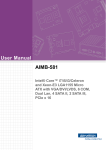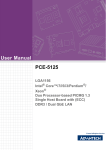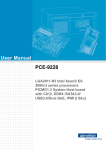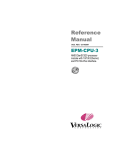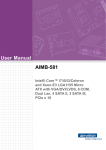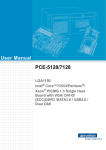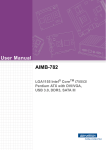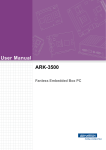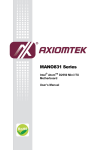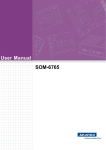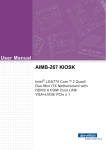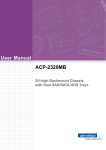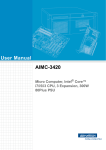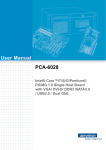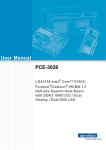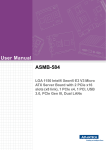Download User Manual PCE-5126
Transcript
User Manual PCE-5126 LGA1155 Intel® Core™i7/i5/i3/Pentium®/ Xeon® PICMG 1.3 Single Host Board with (ECC) DDR3 / Dual GbE LAN Copyright The documentation and the software included with this product are copyrighted 2011 by Advantech Co., Ltd. All rights are reserved. Advantech Co., Ltd. reserves the right to make improvements in the products described in this manual at any time without notice. No part of this manual may be reproduced, copied, translated or transmitted in any form or by any means without the prior written permission of Advantech Co., Ltd. Information provided in this manual is intended to be accurate and reliable. However, Advantech Co., Ltd. assumes no responsibility for its use, nor for any infringements of the rights of third parties, which may result from its use. Acknowledgements AMIBIOS is a trademark of American Megatrends Inc. Intel®, Core™i7/i5/i3, Pentium® Xeon® are trademarks of Intel® Corporation. WinBond is a trademark of Winbond Corporation. All other product names or trademarks are the properties of their respective owners. Product Warranty (2 years) Advantech warrants to you, the original purchaser, that each of its products will be free from defects in materials and workmanship for two years from the date of purchase. This warranty does not apply to any products which have been repaired or altered by persons other than repair personnel authorized by Advantech, or which have been subject to misuse, abuse, accident or improper installation. Advantech assumes no liability under the terms of this warranty as a consequence of such events. Because of Advantech’s high quality-control standards and rigorous testing, most of our customers never need to use our repair service. If an Advantech product is defective, it will be repaired or replaced at no charge during the warranty period. For outof-warranty repairs, you will be billed according to the cost of replacement materials, service time and freight. Please consult your dealer for more details. If you think you have a defective product, follow these steps: 1. Collect all the information about the problem encountered. (For example, CPU speed, Advantech products used, other hardware and software used, etc.) Note anything abnormal and list any onscreen messages you get when the problem occurs. 2. Call your dealer and describe the problem. Please have your manual, product, and any helpful information readily available. 3. If your product is diagnosed as defective, obtain an RMA (return merchandise authorization) number from your dealer. This allows us to process your return more quickly. 4. Carefully pack the defective product, a fully-completed Repair and Replacement Order Card and a photocopy proof of purchase date (such as your sales receipt) in a shippable container. A product returned without proof of the purchase date is not eligible for warranty service. 5. Write the RMA number visibly on the outside of the package and ship it prepaid to your dealer. PCE-5126 User Manual Part No. 2002512600 Edition 1 Printed in China September 2011 ii Declaration of Conformity FCC Class A Note: This equipment has been tested and found to comply with the limits for a Class A digital device, pursuant to part 15 of the FCC Rules. These limits are designed to provide reasonable protection against harmful interference when the equipment is operated in a commercial environment. This equipment generates, uses, and can radiate radio frequency energy and, if not installed and used in accordance with the instruction manual, may cause harmful interference to radio communications. Operation of this equipment in a residential area is likely to cause harmful interference in which case the user will be required to correct the interference at his own expense. Caution! There is a danger of a new battery exploding if it is incorrectly installed. Do not attempt to recharge, force open, or heat the battery. Replace the battery only with the same or equivalent type recommended by the manufacturer. Discard used batteries according to the manufacturer's instructions. A Message to the Customer Advantech Customer Services Each and every Advantech product is built to the most exacting specifications to ensure reliable performance in the harsh and demanding conditions typical of industrial environments. Whether your new Advantech equipment is destined for the laboratory or the factory floor, you can be assured that your product will provide the reliability and ease of operation for which the name Advantech has come to be known. Your satisfaction is our primary concern. Here is a guide to Advantech’s customer services. To ensure you get the full benefit of our services, please follow the instructions below carefully. Technical Support We want you to get the maximum performance from your products. So if you run into technical difficulties, we are here to help. For the most frequently asked questions, you can easily find answers in your product documentation. These answers are normally a lot more detailed than the ones we can give over the phone. So please consult this manual first. If you still cannot find the answer, gather all the information or questions that apply to your problem, and with the product close at hand, call your dealer. Our dealers are well trained and ready to give you the support you need to get the most from your Advantech products. In fact, most problems reported are minor and are able to be easily solved over the phone. In addition, free technical support is available from Advantech engineers every business day. We are always ready to give advice on application requirements or specific information on the installation and operation of any of our products. iii PCE-5126 User Manual Memory Compatibility PCE-5126 Memory Tested for Compatibility Brand Transcend Size Speed ECC Vendor PN 1GB DDR3 1066 N TS128MLK64V1U / 96D3-1G1066NN- SEC K4B1G0846DTS2KNU28100-1S TR HCF8 (128x8) 1GB DDR3 1066 N TS128MLK64V1U 2GB DDR3 1066 N TS256MLK64V1U / 96D3-2G1066NN- SEC K4B1G0846DTS5KNU28300-1S TR HCF9(128x8) 1GB DDR3 1333 N TS128MLK64V3U 1GB DDR3 1333 N TS128MLK64V3U Micron 9GF22 D9KPT (128x8) 2GB DDR3 1333 N TS256MLK64V3U SEC 907 HCH9 K4B1G08460(128x8) 1GB DDR3 1066 N 78.01GC3.420 96D3-1G1066NN- ELPIDA J1108BDSEAP DJ-F (128x8) 2GB DDR3 1066 N 78.A1GC3.421 96D3-2G1066NN- ELPIDA J1108BDSEAP DJ-F (128x8) 4GB DDR3 1066 N 78.B1GDJ.AF1 96D3-1G1066NN- Hynix H5TQ2G83AFR AP H9C (256x8) 1GB DDR3 1333 N 78.A1GC6.421 96D3-1G1333NN- ELPIDA J1108BDBGAP DJ-F (128x8) 2GB DDR3 1333 N 78.A1GC6.421 96D3-2G1333NN- ELPIDA J1108BDBGAP DJ-F (128x8) 2GB DDR3 1333 N 78.A1GDE.AF00C 96D3-2G1333NN- Hynix AP1 H5TQ2G838FR(256x8) 4GB DDR3 1333 N 78.B1GDE.AF1 Hynix H5TQ2G83AFR H9C(256x8) 2GB DDR3 1066 Y 78.A1GC5.423 ELPIDA J1108BDBGDJ-F (128x8) 4GB DDR3 1066 Y 78.B1GDK.AF3 Hynix H5TQ2G83AFR H9C (256x8) 1GB DDR3 1333 Y 78.01GC8.422 96D3-1G1333EAP 2GB DDR3 1333 Y 78.A1GC8.423 96D3-2G1333E- ELPIDA J1108BDBGAP DJ-F (128x8) 4GB DDR3 1333 Y 78.B1GDF.AF3 Hynix H5TQ2G83AFR H9C (256x8) 1GB DDR3 1333 N KVR1333D3N9/1G HYNIX H5TQ1G83BFR H9C 928AK (128x8) 2GB DDR3 1333 N TS128MLK64V3U ELPIDA J1108BDBGDJ-F 093309DLK20 (256x8) 2GB DDR3 1333 N AQ56M72E8BJH9S SEC 952 HCH9 K4B1G0846E (128x8)(128x8) 4GB DDR3 1333 N AQ12M72E8BKH9S Apacer Kingston Advantech PN SEC K4B1G0846D 96D3-1G1066NNHCH9 ENJ038A3 TR (128x8) 96D3-1G1333NN-TR ATP PCE-5126 User Manual iv Memory 96D3-4G1333EAT ELPIDA J1108BDBGDJ-F(128x8) ELPIDA J1108BDBGDJ-F (128x8) SAMSUNG 928 K4B2G0846B-HCH9 (256x8) Specification Comparison Model Name Memory LAN VGA USB COM Remote Management PCE-5126QVG-00A1E Non-ECC 1 GbE Yes 2 SNMP-1000 10 PCE-5126QG2-00A1E Non-ECC 2 GbE Yes 13 2 SNMP-1000 PCE-5126WG2-00A1E ECC/Non-ECC 2 GbE Yes 13 2 SNMP-1000 Processor Support Processor PCE-5126QVG-00A1E PCE-5126QG2-00A1E PCE-5126WG2-00A1E Core i7-2600 Yes Yes - Core i5-2400 Yes Yes - Core i3-2120 Yes Yes Yes Pentium G850 Yes Yes Yes XEON E3-1275 - - Yes XEON E3-1225 - - Yes Backplane Support Matrix Table Backplane Model processor PCE-5XXX PCE-7XXX PCE-5126QVG-00A1E Yes - PCE-5126QG2-00A1E - Yes PCE-5126WG2-00A1E Yes Note! Yes (Except PCE-7B10-04A1E) If PCE-5126 is used on different backplanes which has different PCIe configuration. Below message would be showed on first time power on, and user has to turn off AC power and then turn on for PCIe re-configuration. Caution! PCIe configuration error! Please turn off AC power before re-configuration. v PCE-5126 User Manual Initial Inspection Before you begin installing your motherboard, please make sure that the following materials have been shipped: 1 PCE-5126 PICMG 1.3 Single Host Board 1 PCE-5126 startup manual 1 CD with utility 1 User note for full-sized CPU card 2 Serial ATA HDD data cable 2 Serial ATA HDD power cable 1 COM + printer ports cable kit 1 4-port USB cable kit Keyboard and mouse Y cable 1 jumper package 1 warranty card P/N: 2002721020 P/N: 1700003194 P/N: 1703150102 P/N: 1701260305 P/N: 1700008461 P/N: 1700060202 P/N: 9689000068 If any of these items are missing or damaged, contact your distributor or sales representative immediately. We have carefully inspected the PCE-5126 mechanically and electrically before shipment. It should be free of marks and scratches and in perfect working order upon receipt. As you unpack the PCE-5126, check it for signs of shipping damage. (For example, damaged box, scratches, dents, etc.) If it is damaged or it fails to meet the specifications, notify our service department or your local sales representative immediately. Also notify the carrier. Retain the shipping carton and packing material for inspection by the carrier. After inspection, we will make arrangements to repair or replace the unit. PCE-5126 User Manual vi Contents Chapter 1 Hardware Configuration......................1 1.1 1.2 1.3 1.9 1.10 1.11 1.12 1.13 Introduction ............................................................................................... 2 Features & Benefits................................................................................... 2 Specifications ............................................................................................ 3 1.3.1 System .......................................................................................... 3 1.3.2 Memory ......................................................................................... 3 1.3.3 Input/Output .................................................................................. 4 1.3.4 Graphics........................................................................................ 4 1.3.5 Ethernet LAN ................................................................................ 4 1.3.6 Industrial features ......................................................................... 4 1.3.7 Mechanical and environmental specifications............................... 4 Jumpers and Connectors .......................................................................... 5 Table 1.1: Jumper list .................................................................. 5 Table 1.2: Connector list.............................................................. 5 Board Layout: Jumper and Connector Locations...................................... 6 Figure 1.1 Jumper and connector locations................................. 6 PCE-5126 Block Diagram ......................................................................... 7 Figure 1.2 PCE-5126 block diagram............................................ 7 Safety Precautions .................................................................................... 8 Jumper Settings ........................................................................................ 8 1.8.1 How to set jumpers ....................................................................... 8 1.8.2 BIOS CMOS/ME data clear (JCMOS1/JMECLR1) ....................... 9 Table 1.3: Clear BIOS CMOS/ME Data (JCMOS1/JMECLR1) ... 9 1.8.3 Watchdog timer output (JWDT1) ................................................ 10 Table 1.4: Watchdog timer output (JWDT1) .............................. 10 Table 1.5: H/W monitor alarm (JOBS1).................................... 10 System Memory ...................................................................................... 10 Memory Installation Procedures.............................................................. 11 Cache Memory........................................................................................ 11 Processor Installation.............................................................................. 11 Processor Cooler Installation .................................................................. 13 2 Connecting Peripherals ....................15 2.1 2.2 2.3 2.4 2.5 2.6 2.7 2.8 Introduction ............................................................................................. 16 Parallel Port (LPT1)................................................................................. 16 USB Ports (USB12, USB34, USB56, USB78) ........................................ 16 VGA Connectors (VGA1) ........................................................................ 17 Serial Ports (COM1 & COM2) ................................................................. 17 PS/2 Keyboard and Mouse Connector (KBMS1/KBMS2)....................... 18 CPU Fan Connector (CPUFAN1)............................................................ 18 Front Panel Connectors (JFP1, JFP2 & JFP3) ....................................... 19 2.8.1 Power LED and keyboard lock (JFP3)........................................ 19 Table 2.1: PS/2 or ATX power supply LED status..................... 19 2.8.2 External speaker (JFP2) ............................................................. 20 2.8.3 Reset connector (JFP1) .............................................................. 20 2.8.4 HDD LED connector (JFP2)........................................................ 20 2.8.5 ATX soft power switch (JFP1)..................................................... 20 H/W Monitor/Watchdog Timer/Infrared ................................................... 21 2.9.1 H/W Monitor Alarm (JOBS1)....................................................... 21 2.9.2 Watchdog Timer (JWDT1) .......................................................... 21 2.9.3 Infrared Interface (JIR1).............................................................. 21 LAN Ports (LAN1 & LAN2) ...................................................................... 22 Table 2.2: LAN LED Indicators .................................................. 22 1.4 1.5 1.6 1.7 1.8 Chapter 2.9 2.10 vii PCE-5126 User Manual 2.11 2.15 2.16 High Definition Audio Module Interface (HDAUD1) ................................ 23 Figure 2.1 Jumper and connector locations of PCA-AUDIOHDA1E ..................................................................... 24 GPIO Header (GPIO1)............................................................................ 25 Case Open Connector (JCASE1) ........................................................... 25 Front Panel LAN Indicator Connector (LANLED1).................................. 26 Table 2.3: LAN LED Indicators.................................................. 26 Serial ATA Interface (SATA1~SATA6).................................................... 27 LPC Extension Interface (LPC1)............................................................. 27 3 AMI BIOS Setup................................. 29 3.1 Introduction ............................................................................................. 30 Figure 3.1 Setup program initial screen..................................... 30 Entering Setup ........................................................................................ 31 3.2.1 Main Setup.................................................................................. 31 Figure 3.2 Main setup screen .................................................... 31 3.2.2 Advanced BIOS Features Setup................................................. 32 Figure 3.3 Advanced BIOS features setup screen .................... 32 Figure 3.4 Advantech BIOS Update V1.2.................................. 33 Figure 3.5 ACPI Settings ........................................................... 33 Figure 3.6 TPM Configuration ................................................... 34 Figure 3.7 CPU Configuration ................................................... 35 Figure 3.8 Socket 0 CPU Information........................................ 35 Figure 3.9 SATA Configuration.................................................. 36 Figure 3.10Intel IGD SWSCI OpRegion Configuration............... 37 Figure 3.11Intel Trusted Execution Technology Configuration... 38 Figure 3.12USB Configuration.................................................... 38 Figure 3.13AMT Configuration ................................................... 39 Figure 3.14Super IO Configuration............................................. 40 Figure 3.15Serial Port 1 Configuration ....................................... 40 Figure 3.16Serial Port 2 Configuration ....................................... 41 Figure 3.17Parallel Configuration ............................................... 41 Figure 3.18PC Health Status...................................................... 42 3.2.3 Chipset........................................................................................ 43 Figure 3.19Chipset ..................................................................... 43 Figure 3.20North Bridge ............................................................. 43 Figure 3.21South Bridge............................................................. 44 Figure 3.22USB Configuration.................................................... 45 Figure 3.23ME Subsystem ......................................................... 46 Figure 3.24Chipset Reference Board ......................................... 47 3.2.4 Boot ............................................................................................ 47 Figure 3.25 Boot ......................................................................... 47 3.2.5 Security....................................................................................... 48 Figure 3.26Security .................................................................... 48 3.2.6 Save & Exit ................................................................................. 49 Figure 3.27Save & Exit............................................................... 49 2.12 2.13 2.14 Chapter 3.2 Chapter Chapter 4 Value-Added Software Services ...... 51 4.1 Value-Added Software Services ............................................................. 52 4.1.1 Software API............................................................................... 52 4.1.2 Software Utility............................................................................ 53 5 Chipset Software Installation Utility 55 5.1 5.2 Before You Begin.................................................................................... 56 Introduction ............................................................................................. 56 PCE-5126 User Manual viii 5.3 Windows® XP / Windows® 7 Driver Setup ............................................. 57 6 Integrated Graphic Device Setup .....59 6.1 6.2 Introduction ............................................................................................. 60 Windows XP/Windows 7 Driver Setup .................................................... 60 7 LAN Configuration.............................61 7.1 7.2 7.3 Introduction ............................................................................................. 62 Installation ............................................................................................... 62 Win XP /Win 7 Driver Setup (LAN).......................................................... 62 8 SATA RAID Setup ..............................63 8.1 8.2 Introduction ............................................................................................. 64 SATA RAID Driver and Utility Setup ....................................................... 64 Appendix A Programming the Watchdog Timer..65 A.1 Introduction ............................................................................................. 66 A.1.1 Watchdog timer overview............................................................ 66 A.1.2 Programming the watchdog timer ............................................... 66 Table A.1: Watchdog timer registers.......................................... 67 A.1.3 Example program........................................................................ 68 Appendix B I/O Pin Assignments..........................73 B.1 Parallel Port Connector (LPT1) ............................................................... 74 Table B.1: Parallel port connector (LPT1).................................. 74 VGA Connector (VGA1) .......................................................................... 74 Table B.2: VGA connector (VGA1) ............................................ 74 RS 232 Serial Port (COM2)..................................................................... 75 Table B.3: RS-232 serial port (COM2)....................................... 75 USB Header (USB12 ~ 78) ..................................................................... 75 Table B.4: USB Header (USB12 ~ 78) ...................................... 75 PS/2 Keyboard/Mouse Connector (KBMS1) ........................................... 76 Table B.5: PS/2 keyboard/mouse connector (KBMS1).............. 76 External Keyboard Connector (KBMS2) ................................................. 76 Table B.6: External keyboard connector (KBMS2) .................... 76 CPU Fan Power Connector (CPUFAN1) ................................................ 76 Table B.7: CPU fan power connector (CPUFAN1) .................... 76 Power LED and Keyboard Lock Connector (JFP3 / PWR_LED & KEY LOCK) ..................................................................................................... 77 Table B.8: Power LED and keyboard lock connector (JFP3 / PWR_LED & KEY LOCK)......................................... 77 External Speaker Connector (JFP2 / SPEAKER) ................................... 77 Table B.9: External speaker connector (JFP2 / SPEAKER) ...... 77 Reset Connector (JFP1 / RESET) .......................................................... 77 Table B.10:Reset connector (JFP1 / RESET)............................. 77 HDD LED (JFP2 / HDDLED)................................................................... 78 Table B.11:HDD LED (JFP2 / HDDLED) .................................... 78 ATX Soft Power Switch (JFP1 / PWR_SW) ............................................ 78 Table B.12:ATX soft power switch (JFP1 / PWR_SW) ............... 78 Hi-definition Audio Link Connector (HDAUD1)........................................ 78 Table B.13:Hi-definition audio link connector (HDAUD1) ........... 78 Chapter Chapter Chapter B.2 B.3 B.4 B.5 B.6 B.7 B.8 B.9 B.10 B.11 B.12 B.13 ix PCE-5126 User Manual B.14 B.15 B.16 B.17 B.18 B.19 B.20 B.21 SM Bus Connector (JFP2 / SNMP)......................................................... 79 Table B.14:SM bus connector (JFP2 / SNMP) ........................... 79 LAN1 and LAN2 LED Connector (LANLED1) ......................................... 79 Table B.15:LAN1 and LAN2 LED connector (LANLED1) ........... 79 GPIO Header (GPIO1)............................................................................ 80 Table B.16:GPIO header (GPIO1).............................................. 80 System I/O Ports..................................................................................... 81 Table B.17:System I/O ports....................................................... 81 DMA Channel Assignments .................................................................... 81 Table B.18:DMA channel assignments....................................... 81 Interrupt Assignments ............................................................................. 82 Table B.19:Interrupt assignments............................................... 82 1st MB Memory Map............................................................................... 82 Table B.20:1st MB memory map ................................................ 82 PCI Bus Map........................................................................................... 82 Table B.21:PCI bus map............................................................. 82 Appendix C Programming the GPIO .................... 83 C.1 C.2 C.3 Supported GPIO Register ....................................................................... 84 GPIO registers ........................................................................................ 84 GPIO example program-1....................................................................... 84 PCE-5126 User Manual x Chapter 1 Hardware Configuration 1 1.1 Introduction PCE-5126 is a PICMG 1.3 form-factor single host board which is designed with Intel®B65/Q67/C206 PCH for industrial applications that need high computing power and strong I/O capability. PCE-5126 supports 32nm manufacturing technology, LGA1155 socket Intel® CoreTM i7/i5/i3, Pentium® and XeonTM processors that integrate memory and graphic controllers and supports DDR3 1333 MHz SDRAM up to 8GB. By supporting advanced computing technology, PCE-5126 is suitable for computing power hungry industrial applications. PCE-5126 performs excellent graphic processing capability by its processor integrated Intel® HD Graphics graphic core with shared memory up to 1GB when 2GB and above system memory installed. With this feature, PCE-5126 can provide strong 2D/3D graphic processing power without a discrete graphic card to save extra cost, power consumption and thermal design effort. PCE-5126 also has rich I/O interfaces, and it can support Advantech PCE-5XXX and 7XXX backplanes to offer various expansion slots such as PCI, PCI-X and PCIe slots with its PCIe lanes that are configured as one x16 or two x8 and four x1. New SATA Gen3 (600MB/sec) ports meet high data transfer performance applications, like storage and DVR. Six SATA ports support software RAID 0, 1, 5, 10 to be a cost-effective data reliability solution, the two on-board RS-232 serial ports are for COM port based industrial control applications. With flexible I/O and graphic expandability, PCE-5126 can be an excellent, cost effective graphic or I/O oriented workstation class hardware platform. With outstanding performance and exceptional features, PCE-5126 is the ideal computing platform for advanced industrial applications. Note! Only the workstation WG2 SKU Xeon® processors can support Advantech backplanes of PCE-5XXX series and 7XXX series that are with single or dual PCIe x 8 slot(s). WG2 SKU plus processors other than those mentioned above and QG2, QVG SKUs plus all kinds of processors can ONLY support PCE-5XXX series products. Please see table below for detailed information. Note! Only PCE-5126WG2-00A1E supports Xeon® E3-12XX processors. 1.2 Features & Benefits Features Benefits Intel’s next generation Core i7/i5/i3/Pentium/Xeon Supports Intel’s® next generation Core™ processor cores with quad/dual-core computing i7/i5/i3 Processors. power brings quantum-leap performance improvement. To provide higher memory data transmitting and Supports DDR3 1333MHz SDRAM Max processing efficiency, bringing higher system per8GB. formance. WG2 SKU supports dual PCIe x 8 or one x 16 WG2 SKU supports dual PCIe x 8 or one lane(s) for supporting Advantech backplanes of x 16 lane(s) for supporting both PCEPCE-5XXX series and 7XXX series that are with 7XXX/5XXX series BPs. single or dual PCIe x 8 slot(s). PCE-5126 User Manual 2 To provide higher memory data transmitting reliability, suitable for applications that are sensitive to system stability such as medical, industrial server applications. To reduce customer S/W development effort with Fully supports Advantech SUSI APIs and more reliable S/W quality, also provides valueUtilities. added utilities such as system monitor and Embedded Security ID. 1.3 Specifications 1.3.1 System CPU: LGA1155-socket Core i7/i5/i3, Pentium and Xeon E3-12XX series processors L2 Cache: Core™ i7-2600: Maximum 8 MB Core™ i5-2400: Maximum 6 MB Core™ i3-2120: Maximum 3 MB Pentium® G850: Maximum 3 MB Xeon® E3-12XX: Maximum 8 MB (Only supported by WG2 version) BIOS: AMI SPI BIOS (64 Mb SPI) System Chipset: Intel B65/Q67/C206 platform control hub (PCH) SATA hard disk drive interface: Two SATA3 (600MB/s) are with blue connectors and four SATA2 (300MB/s) are with black connectors. These interfaces can be enabled/disabled in the BIOS. Note! PCE-5126 does NOT support PATA(IDE) interface. 1.3.2 Memory RAM: – WG2 SKU: Up to 8 GB in two 240-pin DIMM sockets. Supports dual-channel DDR3 1066/1333 MHz SDRAM WITH or WITHOUT ECC function. – QVG and QG2 SKUs: Up to 8 GB in two 240-pin DIMM sockets. Supports dual-channel DDR3 1066/1333 MHz SDRAM WITHOUT ECC function. Note! ONLY WG2 SKU support DDR3 memory module with ECC function, QVG and QG2 can ONLY support those with NO ECC. Wrong memory configuration may cause no boot or system instability problems. 3 PCE-5126 User Manual Hardware Configuration To provide high performance storage interface. SATA Gen3 is 6Gb/s which is double bandwidth with SATA Gen2. SATA Gen3 Chapter 1 WG2 SKU supports ECC DDR3 1333MHz SDRAM. 1.3.3 Input/Output Backplane Support: Backplane Support Matrix Table: Model Backplane PCE-5126QVG-00A1E PCE-5XXX PCE-5126QG2-00A1E PCE-5XXX PCE-5126WG2-00A1E PCE-5XXX and PCE-7XXX (Except PCE-7B10-04A1E) PCI bus: Four PCI masters to the backplane, 32-bit, 33 MHz PCI 2.2 compliant. Enhanced parallel port: This EPP/SPP/ECP port can be configured to LPT1, LPT2, LPT3 or disabled. A standard DB-25 female connector provided. Serial ports: Two RS-232 serial ports PS/2 keyboard and mouse connector: One 6-pin mini-DIN connectors is located on the mounting bracket for easy connection to a PS/2 keyboard and mouse via the Y-cable included in the package. USB port: Supports up to 13 USB 2.0 ports with transmission rate up to 480 Mbps. 9 ports are on the CPU card and 4 ports are on the backplane. 1.3.4 Graphics Controller: Intel® HD Graphics embedded in the processor. Display memory: Max. 1 GB shared video memory with system memory ≥ 2 GB. CRT: Up to 2048 x 1536 resolution, 400 MHz RAMDAC. PCI express x16/x8 slot on the backplane: An external graphic card can be installed in the PCI-E x 16/ x 8 slot for stronger 2D/3D graphic capability. 1.3.5 Ethernet LAN Supporting single/dual 10/100/1000 Mbps Ethernet port(s) via the dedicated PCI Express x1 bus which provides 500 MB/s data transmission rate. Controller: – LAN 1: Intel® 82579LM for all SKUs. – LAN 2: Intel® 82583V for QG2 SKU; Intel 82574L for WG2 SKU. 1.3.6 Industrial features Watchdog timer: Can generate a system reset. The watchdog timer is programmable, with each unit equal to one second or one minute (255 levels). 1.3.7 Mechanical and environmental specifications Operating temperature: 0 ~ 60° C (32 ~ 140° F, Depending on CPU) Storage temperature: -40 ~ 85° C (-40 ~ 185° F) Humidity: 20 ~ 95% non-condensing Power supply voltage: +3.3 V, +5 V, +12 V, +5 VSB Power consumption: Processor: Intel Core i7-2600; Memory: 2 DDR3 1333 MHz 2 GB DIMMs Voltage +12 V +5 V +3.3 V +5 VSB Current 6.65A 1.62A 1.98A 0.73A Board size: 338.58 mm (L) x 126.39 mm (W) (13.3" x 4.98") Board weight: 0.490 kg PCE-5126 User Manual 4 Connectors on the PCE-5126 single host board link it to external devices such as hard disk drives and a keyboard. In addition, the board has a number of jumpers used to configure your system for your application. The tables below list the function of each of the board jumpers and connectors. Later sections in this chapter give instructions on setting jumpers. Chapter 2 gives instructions for connecting external devices to your motherboard. Label Function JCMOS1 CMOS clear JMECLR1 ME setup clear JWDT1 Watchdog Reset JOBS1 HW Monitor Alarm Table 1.2: Connector list Label Function LPT1 Parallel port, Parallel port x 1, supports SPP/EPP/ECP mode LAN1 Intel 82579LM for all SKUs LAN2 LAN 2: Intel 82583V for QG2 SKU; Intel 82574L for WG2 SKU VGA1 VGA connector KBMS1 PS/2 keyboard and mouse connector KBMS2 External keyboard/mouse connector COM1 Serial port: COM1; RS-232 (Box Header) COM2 Serial port: COM2; RS-232 (Box Header) JIR1 Infrared connector JFP1 Power Switch / Reset connector JFP2 External speaker / SATA HDD LED connector Suspend: Fast flash (ATX/AT) JFP3 (Keyboard Lock and Power LED) System On: ON (ATX/AT) JCASE1 Case Open CPUFAN1 CPU FAN connector (4-pin) LANLED1 LAN1/2 LED extension connector System Off: OFF (AT) System Off: Slow flash (ATX) HDAUD1 Connector for HD audio extension module USB12 USB port 1, 2 USB34 USB port 3, 4 USB56 USB port 5, 6 USB78 USB port 7, 8 USB9 USB port 9 SATA1 Serial ATA1 SATA2 Serial ATA2 SATA3 Serial ATA3 SATA4 Serial ATA4 SATA5 Serial ATA5 SATA6 Serial ATA6 5 PCE-5126 User Manual Hardware Configuration Table 1.1: Jumper list Chapter 1 1.4 Jumpers and Connectors Table 1.2: Connector list Label Function CPU1 CPU Socket DIMMA1 Memory connector channel A DIMMB1 Memory connector channel B GPIO1 GPIO pin header (SMD pitch-2.0 mm) LPC1 COM port module expansion pin-header 1.5 Board Layout: Jumper and Connector Locations Figure 1.1 Jumper and connector locations PCE-5126 User Manual 6 Chapter 1 1.6 PCE-5126 Block Diagram Hardware Configuration Figure 1.2 PCE-5126 block diagram 7 PCE-5126 User Manual 1.7 Safety Precautions Warning! Always completely disconnect the power cord from your chassis whenever you work with the hardware. Do not make connections while the power is on. Sensitive electronic components can be damaged by sudden power surges. Only experienced electronics personnel should open the PC chassis. Caution! Always ground yourself to remove any static charge before touching the motherboard. Modern electronic devices are very sensitive to static electrical discharges. As a safety precaution, use a grounding wrist strap at all times. Place all electronic components on a static-dissipative surface or in a static-shielded bag when they are not in the chassis. Caution! The computer is provided with a battery-powered Real-time Clock. There is a danger of explosion if battery is incorrectly replaced. Replace only with same or equivalent type recommended by the manufacturer. Discard used batteries according to manufacturer's instructions. Caution! There is a danger of a new battery exploding if it is incorrectly installed. Do not attempt to recharge, force open or heat the battery. Replace the battery only with the same or equivalent type recommended by the manufacturer. Discard used batteries according to the manufacturer’s instructions. 1.8 Jumper Settings This section provides instructions on how to configure your motherboard by setting the jumpers. It also includes the motherboard’s default settings and your options for each jumper. 1.8.1 How to set jumpers You can configure your motherboard to match the needs of your application by setting the jumpers. A jumper is a metal bridge that closes an electrical circuit. It consists of two metal pins and a small metal clip (often protected by a plastic cover) that slides over the pins to connect them. To “close” (or turn ON) a jumper, you connect the pins with the clip. To “open” (or turn OFF) a jumper, you remove the clip. Sometimes a jumper consists of a set of three pins, labeled 1, 2 and 3. In this case you connect either pins 1 and 2, or 2 and 3. A pair of needle-nose pliers may be useful when setting jumpers. PCE-5126 User Manual 8 The PCE-5126 CPU card contains a jumper that can erase BIOS CMOS data and ME (Intel Management Engine) data and reset the system BIOS information. Normally this jumper should be set with pins 1-2 closed. If you want to reset those data, set JCMOS1/JMECLR1 to 2-3 closed for just a few seconds, and then move the jumper back to 1-2 closed. This procedure will reset the CMOS to its last status or default setting. Function Jumper Setting 1 *Keep BIOS CMOS/ME data 1-2 closed Clear BIOS CMOS/ME data 2-3 closed * default setting 9 PCE-5126 User Manual Hardware Configuration Table 1.3: Clear BIOS CMOS/ME Data (JCMOS1/JMECLR1) Chapter 1 1.8.2 BIOS CMOS/ME data clear (JCMOS1/JMECLR1) 1.8.3 Watchdog timer output (JWDT1) The PCE-5126 contains a watchdog timer that will reset the CPU in the event the CPU stops processing. This feature means the PCE-5126 will recover from a software failure or an EMI problem. The JWDT1 jumper settings control the outcome of what the computer will do in the event the watchdog timer is tripped. Table 1.4: Watchdog timer output (JWDT1) Function Jumper Setting 1 * Reset 2-3 closed *default setting Table 1.5: H/W monitor alarm (JOBS1) Function Jumper Setting 1 2 Enabled 1-2 closed 1 Disabled 2 1-2 opened (JOBS1) is a 2-pin connector for setting enable/disable alarm while the on-board security event acts. 1.9 System Memory PCE-5126 has two 240-pin memory sockets for (ECC) DDR3 1066/1333 MHz memory modules with maximum capacity of 8GB. (Maximum 4GB for each DIMM) PCE-5126 QG2 and QVG SKUs support non-ECC DDR3 memory modules. PCE-5126 WG2 SKU supports ECC and non-ECC DDR3 memory modules. Please be noted that PCE-5126 does NOT support registered DIMMs (RDIMMs). PCE-5126 User Manual 10 To install DIMMs, first make sure the two handles of the DIMM socket are in the “open” position. i.e. the handles lean outward. Slowly slide the DIMM module along the plastic guides on both ends of the socket. Then press the DIMM module right down into the socket, until you hear a click. This is when the two handles have automatically locked the memory module into the correct position of the DIMM socket. To remove the memory module, just push both handles outward, and the memory module will be ejected by the mechanism in the socket. Because PCE-5126 supports Intel Active Management Technology 7.0 (iAMT7.0) which utilizes some memory space of channel 0, it's suggested that the user should not leave channel 0 DIMM slots (DIMMA1) empty, or it may cause some system abnormality. 1.11 Cache Memory CPUs supported by PCE-5126 have 8 MB, 6 MB, 3 MB L2 cache memory sizes. 1.12 Processor Installation Warning! Without a fan or heat sink, the processor will overheat and cause damage to both the processor and the single board computer. To install a processor, first turn off your system. The PCE-5126 is designed for Intel® LGA 1155 socket processors. 1. Pull the bar beside the processor socket outward and lift it. 11 PCE-5126 User Manual Hardware Configuration Note! Chapter 1 1.10 Memory Installation Procedures 2. Remove the socket protection cap. 3. Align the cuts on the processor with the edges of the socket. 4. Replace the socket cap; lower the retainer bar and clip it shut. PCE-5126 User Manual 12 Finished processor installation. Chapter 1 5. Purchasing PCE-5126's proprietary CPU cooler (P/N: 1960047831N001) from Advantech is a must. Other brand CPU coolers are NOT compatible with PCE-5126. Advantech offers a specially designed CPU cooler for PCE-5126 for better heat dissipation efficiency and enhancing rigidity of CPU card, part number 1960047831N001. Buy it for PCE-5126 CPU card since it is NOT compatible with other brand CPU coolers (neither is it compatible with Intel boxed CPU cooler). Please install 1960047831N001 CPU cooler following these instructions: Attach the CPU cooler on CPU card by fastening four screws of the CPU cooler into the steel back-plate on PCB. Note the direction of CPU cooler; it must follow that shown above. Installing a CPU cooler in the wrong direction may cause poor heat dissipation that may damage the CPU card. 13 PCE-5126 User Manual Hardware Configuration 1.13 Processor Cooler Installation PCE-5126 User Manual 14 Chapter 2 Connecting Peripherals 2 2.1 Introduction You can access most of the connectors from the top of the board. If you have a number of cards installed, you may need to partially remove the card to make all the connections. 2.2 Parallel Port (LPT1) The parallel port is normally used to connect the motherboard to a printer. The PCE5126 includes an onboard parallel port, accessed through a 26-pin flat-cable connector, LPT1. 2.3 USB Ports (USB12, USB34, USB56, USB78) The PCE-5126 provides up to 9 USB (Universal Serial Bus) on-board ports with complete Plug & Play and hot swap support for up to 127 external devices. These USB ports comply with USB Specification Rev. 2.0, support transmission rates up to 480 Mbps and are fuse protected. The USB interface can be disabled in the system BIOS setup. PCE-5126 User Manual 16 Chapter 2 2.4 VGA Connectors (VGA1) 2.5 Serial Ports (COM1 & COM2) The PCE-5126 offers two serial ports. These ports can connect to serial devices, such as a mouse or a printer, or to a communications network. The IRQ and address ranges for both ports are fixed. However, if you want to disable the port or change these parameters later, you can do this in the system BIOS setup. You can purchase dual COM cable kit if you are a QVG, QG2 or WG2 user and want to use dual COM ports. The P/N is 1701092300. 17 PCE-5126 User Manual Connecting Peripherals The PCE-5126 has VGA outputs that can drive conventional CRT displays. VGA1 is a standard 15-pin D-SUB connector commonly used for VGA. 2.6 PS/2 Keyboard and Mouse Connector (KBMS1/ KBMS2) Two on-board 6-pin mini-DIN connectors (KBMS1) provide connection to PS/2 keyboard and mouse by the Y-cable (1700060202) in the package. The on-board KBMS2 pin header provides connection the front panel PS/2 keyboard and mouse connector of the chassis. 2.7 CPU Fan Connector (CPUFAN1) This connector supports cooling fans of 500 mA (6 W) or less, and it also supports smart fan control when using 4-pin cooler. PCE-5126 User Manual 18 There are several external switches to monitor and control the PCE-5126. JFP3 is a 5-pin connector for the power LED. Refer to Appendix B for detailed information on the pin assignments. If a PS/2 or ATX power supply is used, the system’s power LED status will be as indicated below: Table 2.1: PS/2 or ATX power supply LED status Power mode LED (PS/2 power) LED (ATX power) System On On On System Suspend Flashes Flashes System Off Off Off 19 PCE-5126 User Manual Connecting Peripherals 2.8.1 Power LED and keyboard lock (JFP3) Chapter 2 2.8 Front Panel Connectors (JFP1, JFP2 & JFP3) 2.8.2 External speaker (JFP2) JFP2 is a 4-pin connector for an external speaker. The PCE-5126 provides an onboard buzzer as an alternative to an external speaker. To enable the buzzer, set pins 3 and 4 as closed. 2.8.3 Reset connector (JFP1) Many computer cases offer the convenience of a reset button. Connect the wire from the reset button. 2.8.4 HDD LED connector (JFP2) You can connect an LED to connector JFP2 to indicate when the HDD is active. 2.8.5 ATX soft power switch (JFP1) If your computer case is equipped with an ATX power supply, you should connect the power on/off button on your computer case to JFP1. This connection enables you to turn your computer on and off. PCE-5126 User Manual 20 Connecting Peripherals JWDT1 JOBS1 J JIR1 2.9.1 H/W Monitor Alarm (JOBS1) This 2-pin header is for enabling/disabling H/W monitor alarm function. Closed: Enables OBS Alarm Open: Disables OBS Alarm 2.9.2 Watchdog Timer (JWDT1) This is for setting action trigger by watchdog timer. 1-2 Pin Close: No Action 2-3 Pin Close: System Reset 2.9.3 Infrared Interface (JIR1) This is a 5-pin header for an infrared device. 21 Chapter 2 2.9 H/W Monitor/Watchdog Timer/Infrared PCE-5126 User Manual 2.10 LAN Ports (LAN1 & LAN2) LED2 LED1 The PCE-5126 is equipped with one or two high-performance 1000 Mbps Ethernet LANs. They are supported by all major network operating systems. The RJ-45 jacks on the rear plate provide convenient connectivity. Table 2.2: LAN LED Indicators LAN Mode LED1 LED2 1000Mbps Link On Green On On 1000Mbps Active Green on Flash 1000Mbps Link Off Off Off 100Mbps Link On Orange On On 100Mbps Active Orange On Flash 100Mbps Link Off Off Off 10Mbps Link On Off On 10Mbps Active Off Flash 10Mbps Link Off Off Off PCE-5126 User Manual 22 Note! Advantech 7.1 channel high definition audio module ordering information. P/N: PCA-AUDIO-HDA1E 23 PCE-5126 User Manual Connecting Peripherals This HDAUD1 pin header is the connection interface to Advantech's 7.1 channel high definition audio module. Chapter 2 2.11 High Definition Audio Module Interface (HDAUD1) Connect CDIN1 with the CD/DVD drive's CD-in connector with the audio line included in the CD/DVD drive accessory i Connect CN1 with the power supply's 4-pin power connector Connect HDAUD1 to the HDAUD1 pinheader on the CPU card with the HD audio cable (PN:1701120251) Figure 2.1 Jumper and connector locations of PCA-AUDIO-HDA1E Note! Please remove the yellow jumper cap on the CPU card's HDAUD1 pinheader before connecting the HD audio cable to it. PCE-5126 User Manual 24 Chapter 2 2.12 GPIO Header (GPIO1) 2.13 Case Open Connector (JCASE1) The 2-pin case open connector is for chassis with a case open sensor. When the case is open, the buzzer on motherboard will beep. 25 PCE-5126 User Manual Connecting Peripherals Provides 14-Pin pin header for 8-bit Digital I/O usage. Refer to Appendix B for detailed information on the pin assignments and programming guide in Appendix C. 2.14 Front Panel LAN Indicator Connector (LANLED1) Table 2.3: LAN LED Indicators LAN Mode LED1 LED2 1000Mbps Link On Green On On 1000Mbps Active Green on Flash 1000Mbps Link Off Off Off 100Mbps Link On Orange On On 100Mbps Active Orange On Flash 100Mbps Link Off Off Off 10Mbps Link On Off On 10Mbps Active Off Flash 10Mbps Link Off Off Off PCE-5126 User Manual 26 Note! We recommend to plug CD/DVD drives on SATA3~6. When you install Linux OS, we recommend you to set AHCI mode in BIOS setting. It may recognize no hard drives when you use IDE mode during Linux OS installation. 2.16 LPC Extension Interface (LPC1) LPC1 is a 4-pin female pinheader for adopting Advantech proprietary COM port extension module PCA-COM485-00A1E which features four extra COM ports (serial ports) supporting RS-422/485 with auto flow control function. 27 PCE-5126 User Manual Connecting Peripherals The PCE-5126 features high performance serial ATA interface (2* 600MB/s and 4* 300MB/s) which eases cabling to hard drivers or CD/DVD drivers with long cables. These six on-board SATA ports can be configured as RAID 0, 1, 10, or 5. Please see the detailed BIOS setting instructions for this in Chapter 3. Chapter 2 2.15 Serial ATA Interface (SATA1~SATA6) PCE-5126 User Manual 28 Chapter 3 AMI BIOS Setup 3 3.1 Introduction AMIBIOS has been integrated into motherboards for over a decade. In the past, people often referred to the AMIBIOS setup menu as BIOS, BIOS setup or CMOS setup. With the AMIBIOS Setup program, you can modify BIOS settings and control the special features of your computer. The Setup program uses a number of menus for making changes and turning the special features on or off. This chapter describes the basic navigation of the PCE-5126 setup screens. Figure 3.1 Setup program initial screen AMI’s BIOS ROM has a built-in Setup program that allows users to modify the basic system configuration. This type of information is stored in battery-backup CMOS so it retains the Setup information when the power is turned off. PCE-5126 User Manual 30 Turn on the computer and check for the “patch” code. If there is a number assigned to the patch code, it means that the BIOS supports your CPU. If there is no number assigned to the patch code, please contact an Advantech application engineer to obtain an up-to-date patch code file. This will ensure that your CPU’s system status is valid. After ensuring that you have a number assigned to the patch code, press <DEL> and you will immediately be allowed to enter Setup. When you first enter the BIOS Setup Utility, you will enter the Main setup screen. You can always return to the Main setup screen by selecting the Main tab. There are two Main Setup options. They are described in this section. The Main BIOS Setup screen is shown below. Figure 3.2 Main setup screen The Main BIOS setup screen has two main frames. The left frame displays all the options that can be configured. Grayed-out options cannot be configured; options in blue can. The right frame displays the key legend. Above the key legend is an area reserved for a text message. When an option is selected in the left frame, it is highlighted in white. Often a text message will accompany it. 3.2.1.1 System Time / System Date Use this option to change the system time and date. Highlight System Time or System Date using the <Arrow> keys. Enter new values through the keyboard. Press the <Tab> key or the <Arrow> keys to move between fields. The date must be entered in MM/DD/YY format. The time must be entered in HH:MM:SS format. 31 PCE-5126 User Manual AMI BIOS Setup 3.2.1 Main Setup Chapter 3 3.2 Entering Setup 3.2.2 Advanced BIOS Features Setup Select the Advanced tab from the PCE-5126 setup screen to enter the Advanced BIOS Setup screen. You can select any of the items in the left frame of the screen, such as CPU Configuration, to go to the sub menu for that item. You can display an Advanced BIOS Setup option by highlighting it using the <Arrow> keys. All Advanced BIOS Setup options are described in this section. The Advanced BIOS Setup screen is shown below. The sub menus are described on the following pages. Figure 3.3 Advanced BIOS features setup screen PCE-5126 User Manual 32 Chapter 3 3.2.2.1 Advantech BIOS Update V1.2 AMI BIOS Setup Figure 3.4 Advantech BIOS Update V1.2 You can update BIOS from UPDATE.BIN file in FAT32 storage device 3.2.2.2 ACPI Settings Figure 3.5 ACPI Settings Power Type Choose this item correspond with your power supply type ATX or AT. 33 PCE-5126 User Manual Enable Hibernation "Enable or disable" Hibernate (OS/S4 Sleep State). This option may not be effective with some OSs. Lock Legacy Resources "Enabled" or "Disabled" Lock Legacy Resources. Wake System with Fixed Time "Enabled" or "Disabled" Wake System with Fixed Time. PowerOn by Modem "Enabled" or "Disabled" PowerOn by Modem 3.2.2.3 TPM Configuration Figure 3.6 TPM Configuration TPM Support "Enable or disable" TPM Support. You can purchase Advantech LPC TPM module to enable TPM function. P/N: PCA-TPM-00A1E PCE-5126 User Manual 34 Chapter 3 3.2.2.4 CPU Configuration AMI BIOS Setup Figure 3.7 CPU Configuration Figure 3.8 Socket 0 CPU Information Active Processor Core Use this to select how many processor cores you want to activate when you are using a dual or quad core processor. 35 PCE-5126 User Manual Limit CPUID Maximum Setting this item to [Enable] allows legacy operating systems to boot even without support for CPUs with extended CPUID functions. Execute Disable Bit This item specifies the Execute Disable Bit Feature. The settings are Enabled and Disabled. The Optimal and Fail-Safe default setting is Enabled. If Disabled is selected, the BIOS forces the XD feature flag to always return to 0. Hardware Prefetcher Hardware Prefetcher is a technique that fetches instructions and/or data from memory into the CPU cache memory well before the CPU needs it, so that it can improve the load-to-use latency. You may choose to enable or disable it. Adjacent Cache Line Prefetch The Adjacent Cache-Line Prefetch mechanism, like automatic hardware prefetch, operates without programmer intervention. When enabled through the BIOS, two 64-byte cache lines are fetched into a 128-byte sector, regardless of whether the additional cache line has been requested or not. You may choose to enable or disable it. Intel Virtualization Technology This feature is used to enable or disable the Intel Virtualization Technology (IVT) extension. It allows multiple operating systems to run simultaneously on the same system. It does this by creating virtual machines, each running its own x86 operating system. Power Technology Default is "Energy Efficient". User can set "EIST", "Turbo Mode", “P-STATE", "C3", "C6" and "Package C State Limit" at "CUSTOM Mode" 3.2.2.5 SATA Configuration Figure 3.9 SATA Configuration SATA Mode This can be configured as IDE, RAID, AHCI, or Disabled. PCE-5126 User Manual 36 Serial-ATA Controller 0 This item appears only when you set the SATA Mode item to [IDE Mode]. Set to [Enhanced] to support two SATA 6.0 Gb/s and two SATA 3.0 Gb/s devices. Set to [Compatible] when using Windows 98/NT/2000/MS-DOS. Up to four SATA devices are supported under these operating systems. Serial-ATA Controller 1 This item appears only when you set the SATA Mode item to [IDE Mode]. Set to [Enhanced] to support two SATA 3.0 Gb/s devices. AMI BIOS Setup 3.2.2.6 Intel IGD SWSCI OpRegion Configuration Figure 3.10 Intel IGD SWSCI OpRegion Configuration DVMT/FIXED Memory This item allows user to set video memory. There are three options, [128MB]/ [256MB]/[Maximum] IGD - Boot Type Select the Video Device which will be activated during POST. This has no effect if external graphics present. There are three options, [Auto]/[CRT]/[DVI]. (DVI is optional). Spread Spectrum Clock "Enable or Disable" Spread Spectrum Clock. 37 Chapter 3 PCE-5126 User Manual 3.2.2.7 Intel Trusted Execution Technology Configuration Figure 3.11 Intel Trusted Execution Technology Configuration Intel Trusted Execution Technology Configuration This enables or disables Intel® Trusted Execution Technology 3.2.2.8 USB Configuration Figure 3.12 USB Configuration PCE-5126 User Manual 38 3.2.2.9 AMT Configuration Figure 3.13 AMT Configuration AMT "Enable or Disable" Intel Advance Management Technology Unconfigure AMT/ME "Enable or Disable" Unconfigure AMT/ME WatchDog Timer "Enable or Disable" Watchdog Timer 39 PCE-5126 User Manual AMI BIOS Setup Legacy USB Support This is for supporting USB device under legacy OS such as DOS. When choosing "AUTO", the system will automatically detect if any USB device is plugged into the computer and enable USB legacy mode when a USB device is plugged and disable USB legacy mode when no USB device is plugged. EHCI Hand-off This enables or disables supporting OS without EHCI hand-off feature. USB transfer time-out Allows you to select the USB transfer time-out value. [1,5,10,20sec] Device reset time-out Allows you to select the USB device reset time-out value. [1,5,10,20sec] Device power-up delay This item appears only when you set the Device power-up delay item to [manual]. USB FLASH DRIVE 1.01* This item only show when plugging a USB flash device. User can choose "Auto", "Floppy", "Forced FDD", "Hard Disk" and "CD-ROM" to simulate USB flash device. * This item will change wording which depends on what USB storage device you plug. Chapter 3 3.2.2.10 Super IO Configuration Figure 3.14 Super IO Configuration Figure 3.15 Serial Port 1 Configuration PCE-5126 User Manual 40 Chapter 3 AMI BIOS Setup Figure 3.16 Serial Port 2 Configuration Figure 3.17 Parallel Configuration Serial Port "Enable or Disable" Serial Port Parallel Port "Enable or Disable" Parallel Port 41 PCE-5126 User Manual 3.2.2.11 PC Health Status Figure 3.18 PC Health Status Case Open Warning Enable/Disable the Chassis Intrusion monitoring function. When enabled and the case is opened, the speaker beeps. CPU Warning Temperature Use this to set the CPU warning temperature threshold. When the system reaches the warning temperature, the speaker will beep. ACPI Shutdown Temperature Use this to set the ACPI shutdown temperature threshold. When the system reaches the shutdown temperature, it will be automatically shut down by ACPI OS to protect the system from overheating damage. CPUFAN Mode Setting "Enable or Disable" CPUFAN Mode to SMART FAN setting PCE-5126 User Manual 42 Chapter 3 3.2.3 Chipset AMI BIOS Setup Figure 3.19 Chipset 3.2.3.1 North Bridge Figure 3.20 North Bridge Low MMIO Align Low MMIO resources align at 64MB/1024MB. 43 PCE-5126 User Manual VT-d To support Intel chipset virtualization technology for directed I/O. Initiate Graphic Adapter This setting allows users to select which graphics controller to be the primary graphic device when booting up. IGD Memory Allows users to select integrated graphic memory. Render Standby "Enable, Disable" Render Standby by Internal Graphics Device IGD Multi-Monitor 'Enable, Disable" IGD Multi-monitor by Internal Graphics Internal Device PEG Force Gen1 Allows users to force PEG port downgrade to Gen1. Detect Non-Compliance Device "Enable, Disable" Detect Non-Compliance Device 3.2.3.2 South Bridge Figure 3.21 South Bridge SMBus Controller "Enable or Disable" SMBus Controller. LAN2 Controller "Enable or Disable" LAN2 Controller. LAN Option-ROM "Enable or Disable" LAN Option-ROM. Wake on LAN from S5 "Enable or Disable" Wake on LAN from S5. PCE-5126 User Manual 44 Note! When a system enters G3 status with Deep S5 enabled, some power supply’s 5 VSB won’t drop until after more than 30 seconds. If “Restore AC Power Loss“ is set to “power on“, the system won’t boot up in 30 seconds after power failure. We recommend the users wait for more than 30 seconds to power on after a power failure. The system will auto power on if power is restored within 30 seconds, before 5 VSB actually drops, even if “Restore AC Power Loss“ is set to “power off“. 3.2.3.3 USB Configuration Figure 3.22 USB Configuration All USB Devices "Enable or Disable" All USB Devices. EHCI Controller #1 & #2 "Enable or Disable" EHCI Controller #1 or #2. 45 PCE-5126 User Manual AMI BIOS Setup Restore AC Power Loss 'Power Off, power On or Last State" to restore AC power loss SLP_S4 Assertion Stretch Enable "Enable" to select a minimum assertion width of the SLP_S4 signal SLP_S4 Assertion Width "1-2,2-3,3-4,4-5" SLP_S4 assertion width help Azalia HD Audio "Enable or Disable" HD Audio for optional PCA-AUDIO-HDA1E High Precision Timer "Enable or Disable" High Precision Event Timer Deep S5 “Enable for Disable“ Deep S5 feature. When Deep D5 is enabled, most power, including 5 VASB, will be off during Deep S5 for energy savings. Chapter 3 USB Port 1~14 "Enable or Disable" USB Port 1~14. 3.2.3.4 ME Subsystem Figure 3.23 ME Subsystem ME Subsystem "Enable or Disable" Intel Management Engine Subsystem. ME Temporary Disable "Enable or Disable" ME Temporary Disable End of Post Message "Enable or Disable" End of Post Message. Execute MEBx "Enable or Disable" Execute MEBx to show "Ctrl+P" to enter ME setup during post screen MEBx Mode "Normal, Hidden Ctrl+P, Enter MEBx Setup" to use ME setup PCE-5126 User Manual 46 Chapter 3 3.2.3.5 Chipset Reference Board AMI BIOS Setup Figure 3.24 Chipset Reference Board CIRA Trigger "Enable or Disable" CIRA Trigger. 3.2.4 Boot Figure 3.25 Boot 47 PCE-5126 User Manual Setup Prompt Timeout Use the <+> and <-> keys to adjust the number of seconds to wait for setup activation key. Bootup NumLock State "On or Off" power-on state for the NumLock Quiet Boot If this option is set to Disabled, the BIOS displays normal POST messages. If Enabled, an OEM Logo is shown instead of POST messages. Option ROM Messages "Force BIOS or Keep Current" to set the display mode for Option ROM Interrupt 19 Capture "Enable or Disable" Option ROM to trap Interrupt 19 Boot Option Choose boot priority from boot device 3.2.5 Security Figure 3.26 Security Select Security Setup from the PCE-5126 Setup main BIOS setup menu. All Security Setup options, such as password protection and virus protection are described in this section. To access the sub menu for the following items, select the item and press <Enter> PCE-5126 User Manual 48 Chapter 3 3.2.6 Save & Exit AMI BIOS Setup Figure 3.27 Save & Exit Save changes and exit* When you have completed system configuration, select this option to save your changes, exit BIOS setup and boot into the OS so the new system configuration parameters can take effect. Discard changes and exit Select this option to quit Setup without making any permanent changes to the system configuration. Save changes and Reset When you have completed system configuration, select this option to save your changes, exit BIOS setup and reboot into the computer so the new system configuration parameters can take effect. Discard changes and Reset Select this option to quit Setup and reset computer without making any permanent changes to the system configuration. Save Changes Select this option to save your changes. Discard Changes Select this option to discard your changes. 49 PCE-5126 User Manual Restore Defaults Select this option to restore BIOS configuration as origin. Save as User Defaults Select this option to save user's configuration. Restore User Defaults Select this option to restore BIOS to user's configuration. Launch EFI Shell from file system device This option allows you to attempt to launch the EFI Shell application (shellx64.efi) from one of the available file system devices. *When you do some critical changes, the system will still reboot even you choose "Save changes and exit". PCE-5126 User Manual 50 Chapter 4 4 Value-Added Software Services 4.1 Value-Added Software Services Software API: An interface that defines the ways in which an application program may request services from libraries and/or operating systems. Provides not only the underlying drivers required but also a rich set of user-friendly, intelligent and integrated interfaces, which speeds development, enhances security and offers add-on value for Advantech platforms. It plays the role of catalyst between developer and solution, and makes Advantech embedded platforms easier and simpler to adopt and operate with customer applications. The API and utility is only for XP, and if user needs Linux version API and utility, please contact with Advantech representative for support it. 4.1.1 Software API 4.1.1.1 Control GPIO General Purpose Input/Output is a flexible parallel interface that allows a variety of custom connections. allows users to monitor the level of signal input or set the output status to switch on/off the device. Our API also provides Programmable GPIO, which allows developers to dynamically set the GPIO input or output status. 4.1.1.2 Monitor Watchdog A watchdog timer (WDT) is a device that performs a specific operation after a certain period of time if something goes wrong and the system does not recover on its own. A watchdog timer can be programmed to perform a warm boot (restarting the system) after a certain number of seconds. Hardware Monitor The Hardware Monitor (HWM) API is a system health supervision API that inspects certain condition indexes, such as fan speed, temperature and voltage. PCE-5126 User Manual 52 Embedded Security ID Monitoring The Monitoring utility allows the customer to monitor system health, including voltage, CPU and system temperature and fan speed. These items are important to a device; if critical errors happen and are not solved immediately, permanent damage may be caused. eSOS The eSOS is a small OS stored in BIOS ROM. It will boot up in case of a main OS crash. It will diagnose the hardware status, and then send an e-mail to a designated administrator. The eSOS also provides remote connection: Telnet server and FTP server, allowing the administrator to rescue the system. Note: This function requires BIOS customization. 53 PCE-5126 User Manual Value-Added Software Services The embedded application is the most important property of a system integrator. It contains valuable intellectual property, design knowledge and innovation, but it is easily copied! The Embedded Security ID utility provides reliable security functions for customers to secure their application data within the embedded BIOS. Chapter 4 4.1.2 Software Utility PCE-5126 User Manual 54 Chapter 5 Chipset Software Installation Utility 5 5.1 Before You Begin To facilitate the installation of the enhanced display drivers and utility software, read the instructions in this chapter carefully. The drivers for the PCE-5126 are located on the software installation CD. The driver in the folder of the driver CD will guide and link you to the utilities and drivers under a Windows system. Updates are provided via Service Packs from Microsoft®. Note! The files on the software installation CD are compressed. Do not attempt to install the drivers by copying the files manually. You must use the supplied SETUP program to install the drivers. Before you begin, it is important to note that most display drivers need to have the relevant software application already installed in the system prior to installing the enhanced display drivers. In addition, many of the installation procedures assume that you are familiar with both the relevant software applications and operating system commands. Review the relevant operating system commands and the pertinent sections of your application software’s user manual before performing the installation. 5.2 Introduction The Intel® Chipset Software Installation (CSI) utility installs the Windows INF files that outline to the operating system how the chipset components will be configured. This is needed for the proper functioning of the following features: Core PCI PnP services Serial ATA interface support USB 1.1/2.0 support Identification of Intel® chipset components in the Device Manager Integrates superior video features. These include filtered sealing of 720 pixel DVD content, and MPEG-2 motion compensation for software DVD PCE-5126 User Manual 56 1. Insert the driver CD into your system’s CD-ROM drive. You can see the driver folder items. Navigate to the "01-Chipset" folder and click "infinst_autol.exe" to complete the installation of the driver. Note! 57 PCE-5126 User Manual Chipset Software Installation Utility Wrong driver installation may cause unexpected system instability. The drivers on this CD support both Windows XP 32-bit /64-bit and Windows 7 32-bit/64-bit. Chapter 5 5.3 Windows® XP / Windows® 7 Driver Setup PCE-5126 User Manual 58 Chapter 6 6 Integrated Graphic Device Setup 6.1 Introduction The Intel® LGA1155 CPUs have integrated graphics controllers. You need to install the VGA driver to enable this function, which includes the following features: Optimized integrated graphic solution: Intel Graphics Flexible Display Interface supports versatile display options and 32-bit 3D graphics engine. Dual independent display, enhanced display modes for widescreen flat panels for extend, twin, and clone dual display mode, and optimized 3D support deliver an intensive and realistic visual experience. 6.2 Windows XP/Windows 7 Driver Setup Note! Before installing this driver, make sure the INF driver has been installed in your system. See Chapter 5 for information on installing the INF driver. Insert the driver CD into your system’s CD-ROM drive. You can see the driver folder items. Navigate to the "VGA" folder and click "setup.exe" to complete the installation of the driver. Note! Wrong driver installation may cause unexpected system instability. PCE-5126 User Manual 60 Chapter 7 7 LAN Configuration 7.1 Introduction The PCE-5126 has dual Gigabit Ethernet LANs via dedicated PCI Express x1 lanes (Intel 82579LM (LAN1) and 82583V (LAN2 of QG2) or 82574L (LAN2 of WG2) that offer bandwidth of up to 500 MB/sec, eliminating the bottleneck of network data flow and incorporating Gigabit Ethernet at 1000 Mbps. 7.2 Installation Note! Before installing the LAN drivers, make sure the CSI utility has been installed on your system. See Chapter 5 for information on installing the CSI utility. The PCE-5126's Intel 82579LM (LAN1) and 82583V/82574L (LAN2) Gigabit integrated controllers support all major network operating systems. However, the installation procedure varies from system to system. Please find and use the section that provides the driver setup procedure for the operating system you are using. 7.3 Win XP /Win 7 Driver Setup (LAN) Insert the driver CD into your system’s CD-ROM drive. Navigate to the "04-LAN" folder and click "setup.exe" to complete the installation of the driver. Note! Wrong driver installation may cause unexpected system instability. PCE-5126 User Manual 62 Chapter 8 SATA RAID Setup 8 8.1 Introduction To support demanding disk I/O, Intel Q67/C206 chipset integrates six Serial ATA controllers with software RAID 0, 1, 5, 10 capabilities. RAID 0 striping increases the storage performance and is designed to speed up data transfer rates for disk-intensive applications. RAID 1 mirroring protects valuable data that might be lost in the event of a hard drive failure. RAID 5 array contains three or more hard drives where the data is divided into manageable blocks called strips. Parity is a mathematical method for recreating data that was lost from a single drive, which increases fault-tolerance. The data and parity are striped across all the hard drives in the array. The parity is striped in a rotating sequence to reduce bottlenecks associated with the parity calculations. RAID 10 array uses four hard drives to create a combination of RAID levels 0 and 1. The data is striped across a two-drive array forming the RAID 0 component. Each of the drives in the RAID 0 array is then mirrored by a RAID 1 component. 8.2 SATA RAID Driver and Utility Setup Note! For the detailed installation instructions for the SATA RAID driver and utility, please check the User Guide in the driver CD. Path: Others\RAID Note! Before you install the Intel® Matrix Storage Manager, please read the "readme.txt" which is in the folder “Others\RAID”. The driver is in the CD’s “Others\RAID” folder.You may go to the directory of the CD and follow Intel's installation guide to install the driver and utility. PCE-5126 User Manual 64 Appendix A A Programming the Watchdog Timer A.1 Introduction The PCE-5126’s watchdog timer can be used to monitor system software operation and take corrective action if the software fails to function within the programmed period. This section describes the operation of the watchdog timer and how to program it. A.1.1 Watchdog timer overview The watchdog timer is built in to the NCT6776F super I/O controller. It provides the following user programmable functions: Can be enabled and disabled by user’s program Timer can be set from 1 to 255 seconds or 1 to 255 minutes Generates reset signal if the software fails to reset the timer before time-out A.1.2 Programming the watchdog timer The I/O port address of the watchdog timer is 2E (hex) and 2F (hex). 2E (hex) is the address port. 2F (hex) is the data port. You must first write an address value into address port 2E (hex), then write/read data to/from the assigned register through data port 2F (hex). PCE-5126 User Manual 66 Appendix A Programming the Watchdog Timer Unlock NCT6776F Select register of watchdog timer Enable the function of the watchdog timer Use the function of the watchdog timer Lock NCT6776F Table A.1: Watchdog timer registers Address of register (2E) Attribute Read/Write Value (2F)& description 87 (hex) ----- Write this address to I/O address port 2E (hex) twice to unlock the NCT6776F 07 (hex) write Write 08 (hex) to select register of watchdog timer. write Write 01 (hex) to enable the function of the watchdog timer. Disabled is set as default. write Set seconds or minutes as units for the timer. Write 0 to bit 3: set second as counting unit. [default]. Write 1 to bit 3: set minutes as counting unit Write 1 to bit 4: Watchdog timer count mode is 1000 times faster. If bit 3 is 0, the count mode is 1/1000 seconds mode. If bit 3 is 1, the count mode is 1/1000 minutes mode. 30 (hex) F5 (hex) 67 PCE-5126 User Manual write 0: stop timer [default] 01~FF (hex): The amount of the count, in seconds or minutes, depends on the value set in register F5 (hex). This number decides how long the watchdog timer waits for strobe before generating an interrupt or reset signal. Writing a new value to this register can reset the timer to count with the new value. F7 (hex) read/write Bit 6: Write 1 to enable keyboard to reset the timer, 0 to disable.[default] Bit 5: Write 1 to generate a timeout signal immediately and automatically return to 0. [default=0] Bit 4: Read status of watchdog timer, 1 means timer is “timeout”. AA (hex) ----- Write this address to I/O port 2E (hex) to lock the NCT6676F. F6 (hex) A.1.3 Example program 1. Enable watchdog timer and set 10 sec. as timeout interval ;----------------------------------------------------------Mov dx,2eh ; Unlock NCT6676F Mov al,87h Out dx,al Out dx,al ;----------------------------------------------------------Mov al,07h ; Select registers of watchdog timer Out dx,al Inc dx Mov al,08h Out dx,al ;----------------------------------------------------------Dec dx ; Enable the function of watchdog timer Mov al,30h Out dx,al Inc dx In al,dx Or al,01h Out dx,al ;----------------------------------------------------------Dec dx ; Set second as counting unit Mov al,0f5h Out dx,al Inc dx In al,dx And al,not 08h Out dx,al ;----------------------------------------------------------Dec dx ; Set timeout interval as 10 seconds and start counting Mov al,0f6h PCE-5126 User Manual 68 2. Enable watchdog timer and set 5 minutes as timeout interval ;----------------------------------------------------------Mov dx,2eh ; Unlock NCT6776F Mov al,87h Out dx,al Out dx,al ;----------------------------------------------------------Mov al,07h ; Select registers of watchdog timer Out dx,al Inc dx In al,dx Or al,08h Out dx,al ;----------------------------------------------------------Dec dx ; Enable the function of watchdog timer Mov al,30h Out dx,al Inc dx Mov al,01h Out dx,al ;----------------------------------------------------------Dec dx ; Set minute as counting unit Mov al,0f5h Out dx,al Inc dx In al,dx Or al,08h Out dx,al ;----------------------------------------------------------Dec dx ; Set timeout interval as 5 minutes and start counting Mov al,0f6h Out dx,al Inc dx Mov al,5 ; 5 minutes Out dx,al ;----------------------------------------------------------- 69 PCE-5126 User Manual Appendix A Programming the Watchdog Timer Out dx,al Inc dx Mov al,10 ; 10 seconds Out dx,al ;----------------------------------------------------------Dec dx ; Lock NCT6776F Mov al,0aah Out dx,al Dec dx Mov al,0aah Out dx,al ; Lock NCT6776F 3. Enable watchdog timer to be reset by mouse ;----------------------------------------------------------Mov dx,2eh ; Unlock NCT6776F Mov al,87h Out dx,al Out dx,al ;----------------------------------------------------------Mov al,07h ; Select registers of watchdog timer Out dx,al Inc dx Mov al,08h Out dx,al ;----------------------------------------------------------Dec dx ; Enable the function of watchdog timer Mov al,30h Out dx,al Inc dx In al,dx Or al,01h Out dx,al ;----------------------------------------------------------Dec dx ; Enable watchdog timer to be reset by mouse Mov al,0f7h Out dx,al Inc dx In al,dx Or al,80h Out dx,al ;----------------------------------------------------------Dec dx ; Lock NCT6776F Mov al,0aah Out dx,al 4. Enable watchdog timer to be reset by keyboard ;----------------------------------------------------------Mov dx,2eh ; Unlock NCT6776F Mov al,87h Out dx,al Out dx,al ;----------------------------------------------------------Mov al,07h ; Select registers of watchdog timer PCE-5126 User Manual 70 5. Generate a time-out signal without timer counting ;----------------------------------------------------------Mov dx,2eh ; Unlock NCT6776F Mov al,87h Out dx,al Out dx,al ;----------------------------------------------------------Mov al,07h ; Select registers of watchdog timer Out dx,al Inc dx Mov al,08h Out dx,al ;----------------------------------------------------------Dec dx ; Enable the function of watchdog timer Mov al,30h Out dx,al Inc dx Mov al,01h Out dx,al ;----------------------------------------------------------Dec dx ; Generate a time-out signal 71 PCE-5126 User Manual Appendix A Programming the Watchdog Timer Out dx,al Inc dx Mov al,08h Out dx,al ;----------------------------------------------------------Dec dx ; Enable the function of watchdog timer Mov al,30h Out dx,al Inc dx Mov al,01h Out dx,al ;----------------------------------------------------------Dec dx ; Enables watchdog timer to be strobe reset by keyboard Mov al,0f7h Out dx,al Inc dx In al,dx Or al,40h Out dx,al ;----------------------------------------------------------Dec dx ; Lock NCT6776F Mov al,0aah Out dx,al Mov al,0f7h Out dx,al ;Write 1 to bit 5 of F7 register Inc dx In al,dx Or al,20h Out dx,al ;----------------------------------------------------------Dec dx ; Lock NCT6776F Mov al,0aah Out dx,al PCE-5126 User Manual 72 Appendix B B I/O Pin Assignments B.1 Parallel Port Connector (LPT1) 25 23 3 1 26 24 4 2 Table B.1: Parallel port connector (LPT1) Pin Signal Pin Signal 1 STROBE* 2 AUTOFD* 3 D0 4 ERR 5 D1 6 INIT* 7 D2 8 SLCTINI* 9 D3 10 GND 11 D4 12 GND 13 D5 14 GND 15 D6 16 GND 17 D7 18 GND 19 ACK* 20 GND 21 BUSY 22 GND 23 PE 24 GND 25 SLCT 26 N/C * low active B.2 VGA Connector (VGA1) 5 1 10 6 15 11 Table B.2: VGA connector (VGA1) Pin Signal 1 RED 9 VCC 2 GREEN 10 GND 3 BLUE 11 N/C 4 N/C 12 SDT 5 GND 13 H-SYNC 6 GND 14 V-SYNC 7 GND 15 SCK 8 GND PCE-5126 User Manual Pin 74 Signal Appendix B I/O Pin Assignments B.3 RS 232 Serial Port (COM2) Table B.3: RS-232 serial port (COM2) Pin Signal 1 DCD 2 DSR 3 SIN 4 RTS 5 SOUT 6 CTS 7 DTR 8 RI 9 GND B.4 USB Header (USB12 ~ 78) Table B.4: USB Header (USB12 ~ 78) Pin Signal Pin Signal 1 USB1_VCC5 6 USB2_D+ 2 USB2_VCC5 7 GND 3 USB1_D- 8 GND 4 USB2_D- 9 Key 5 USB1_D+ 10 NC 75 PCE-5126 User Manual B.5 PS/2 Keyboard/Mouse Connector (KBMS1) 6 5 4 3 2 1 Table B.5: PS/2 keyboard/mouse connector (KBMS1) Pin Signal 1 KB DATA 2 MS DATA 3 GND 4 VCC 5 KB CLOCK 6 MS CLOCK B.6 External Keyboard Connector (KBMS2) 6 5 4 3 2 1 Table B.6: External keyboard connector (KBMS2) Pin Signal 1 KBCLK 2 KBDAT 3 MSDAT 4 GND 5 MSVCC 6 MSCLK B.7 CPU Fan Power Connector (CPUFAN1) 1 2 3 4 Table B.7: CPU fan power connector (CPUFAN1) Pin Signal 1 GND 2 +12V 3 Detect 4 NC PCE-5126 User Manual 76 Table B.8: Power LED and keyboard lock connector (JFP3 / PWR_LED & KEY LOCK) Pin Signal 1 LED power (+3.3 V) 2 NC 3 SUPLED 4 KEYLOCK# 5 GND B.9 External Speaker Connector (JFP2 / SPEAKER) Table B.9: External speaker connector (JFP2 / SPEAKER) Pin Signal 1 SPK_CN17P1 2 SPK_CN17P2 3 SPK_CN17P3 4 SPK_CN17P4 B.10 Reset Connector (JFP1 / RESET) Table B.10: Reset connector (JFP1 / RESET) Pin Signal 1 RESET # 2 GND 77 PCE-5126 User Manual Appendix B I/O Pin Assignments B.8 Power LED and Keyboard Lock Connector (JFP3 / PWR_LED & KEY LOCK) B.11 HDD LED (JFP2 / HDDLED) Table B.11: HDD LED (JFP2 / HDDLED) Pin Signal 1 HDD LED 2 SATA LED B.12 ATX Soft Power Switch (JFP1 / PWR_SW) Table B.12: ATX soft power switch (JFP1 / PWR_SW) Pin Signal 1 5VSB 2 PWR-BTN B.13 Hi-definition Audio Link Connector (HDAUD1) Table B.13: Hi-definition audio link connector (HDAUD1) Pin Signal Pin Signal 1 ACZ_VCC 2 GND 3 ACZ_SYNC 4 ACZ_BITCLK 5 ACZ_SDOUT 6 ACZ_SDIN0 7 ACZ_SDIN1 8 -ACZ_RST 9 ACZ_12V 10 GND 11 GND 12 N/C PCE-5126 User Manual 78 Table B.14: SM bus connector (JFP2 / SNMP) Pin Signal 1 SMB_DATA 2 SMB_CLK B.15 LAN1 and LAN2 LED Connector (LANLED1) 1 3 5 7 9 2 4 6 8 Table B.15: LAN1 and LAN2 LED connector (LANLED1) Pin Signal 1 #LAN1_ACT 2 #LAN2_ACT 3 V33_AUX 4 V33_AUX 5 #LAN1_LINK1000 6 #LAN2_LINK1000 7 #LAN1_LINK100 8 #LAN2_LINK100 9 V33_AUX 79 PCE-5126 User Manual Appendix B I/O Pin Assignments B.14 SM Bus Connector (JFP2 / SNMP) B.16 GPIO Header (GPIO1) 1 2 3 4 5 6 7 8 9 10 Table B.16: GPIO header (GPIO1) Pin Signal 1 SIO_GPIO0 2 SIO_GPIO4 3 SIO_GPIO1 4 SIO_GPIO5 5 SIO_GPIO2 6 SIO_GPIO6 7 SIO_GPIO3 8 SIO_GPIO7 9 VCC_GPIO 10 GND PCE-5126 User Manual 80 Appendix B I/O Pin Assignments B.17 System I/O Ports Table B.17: System I/O ports Addr. range (Hex) Device 00h-1Fh DMA Controller 20h-2Dh Interrupt Controller 2E-2F LPC SIO 30h-42h Interrupt Controller 43h Timer/Counter 4E-4F LPC SIO 50h-53h Timer/Counter 60h-66h Microcontroller 70h-77h RTC Controller 80h-91h DMA Controller 92h Reset Generator 93h-9Fh DMA Controller A0h-B1h Interrupt Controller B2h-B3h Power Management B4h-BDh Interrupt Controller C0h-DHh DMA Controller F0h Interrupt Controller 1F0h-1F7h SATA Controller or PCI 290h-29Fh H/W Monitor 376h-3F6h SATA Controller or PCI 4D0h-4D1h Interrupt Controller C80h-CBFh Com3-Com6 3F8-3FF Com1 2F8-2F0 Com2 4700-470F TPM 600h-67Fh SMSC Secondary I/O used B.18 DMA Channel Assignments Table B.18: DMA channel assignments Channel Signal 0 Available 1 Available 2 Floppy disk (8-bit transfer) 3 Available 4 Cascade for DMA controller 1 5 Available 6 Available 7 Available 81 PCE-5126 User Manual B.19 Interrupt Assignments Table B.19: Interrupt assignments Priority Interrupt# Interrupt source 1 NMI Parity error detected 2 IRQ0 Interval timer 3 IRQ1 Keyboard - IRQ2 Interrupt from controller 2 (cascade) 4 IRQ8 Real-time clock 5 IRQ9 Cascaded to INT 0A (IRQ 2) 6 IRQ10 Serial Port 4, 6 7 IRQ11 Serial Port 3, 5 8 IRQ12 PS/2 mouse 9 IRQ13 INT from co-processor 10 IRQ14 Primary IDE Channel 11 IRQ15 Secondary IDE Channel 12 IRQ3 Serial communication port 2 13 IRQ4 Serial communication port 1 14 IRQ5 NA 15 IRQ6 NA 16 IRQ7 Parallel port 1 (print port) B.20 1st MB Memory Map Table B.20: 1st MB memory map Addr. range (Hex) Device E0000h - FFFFFh BIOS CF000h - 0FFFFh Unused C0000h - CBFFFh VGA BIOS A0000h - BFFFFh Video Memory 00000h - 9FFFFh Base memory B.21 PCI Bus Map Table B.21: PCI bus map Signal IDSEL INT# pin PCI slot 1 AD31 INT B,C,D,A GNT A REQ A PCI slot 2 AD30 INT C, D, A, B GNT B REQ B PCI slot 3 AD29 INT D,A,B,C GNT C REQ C PCI slot 4 AD28 INT A, B, C, D GNT D REQ D PCE-5126 User Manual GNT 82 REQ Appendix C C Programming the GPIO C.1 Supported GPIO Register Below are the detailed descriptions of the GPIO addresses and programming sample. C.2 GPIO registers Bank Offset Description 09h 30h Write 1 to bit 7 to enable GPIO E0h GPIO I/O Register When set to a '1', respective GPIO port is programmed as an input port. When set to a '0', respective GPIO port is programmed as an output port. E1h GPIO Data Redister If a port is programmed to be an output port, then its respective bit can be read/written. If a port is programmed to be an input port, then its respective bit can only be read. E2h GPIO Inversion Register When set to a '1', the incoming/outgoing port value is inverted. When set to a '0', the incoming/outgoing port value is the same as in data register. 07h 07h 07h C.3 GPIO example program-1 -----------------------------------------------Enter the extended function mode, interruptible double-write -----------------------------------------------MOV DX,2EH MOV AL,87H OUT DX,AL OUT DX,AL --------------------------------------------------------------Configure logical device, configuration register CRE0,CRE1,CRE2 --------------------------------------------------------------MOV DX,2EH MOV AL,09H OUT DX,AC DEC DX MOV AL,30H OUT DX,AL INC DX IN AL,DX OR AL,10000000B DEC DX MOV AL,07H OUT DX,AL PCE-5126 User Manual 84 85 Appendix C Programming the GPIO INC DX MOV AL,07H ; Select logical device 7 OUT DX,AL ; DEC DX MOV AL,E0H OUT DX,AL INC DX MOV AL,00H ; 1:Input 0:output for GPIO respective OUT DX,AL DEC DX MOV AL,E2H ; OUT DX,AL INC DX MOV AL,00H ;Set GPIO is normal not inverter OUT DX,AL; DEC DX MOV AL,E1H OUT DX,AL INC DX MOV AL,??H ; Put the output value into AL OUT DX,AL -----------------------------------------Exit extended function mode | -----------------------------------------MOV DX,2EH MOV AL,AAH OUT DX,AL PCE-5126 User Manual www.advantech.com Please verify specifications before quoting. This guide is intended for reference purposes only. All product specifications are subject to change without notice. No part of this publication may be reproduced in any form or by any means, electronic, photocopying, recording or otherwise, without prior written permission of the publisher. All brand and product names are trademarks or registered trademarks of their respective companies. © Advantech Co., Ltd. 2011
































































































